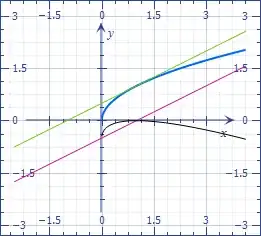Let's start with your $f'(x)= \lim\limits_{\Delta x\to 0} \frac{\Delta (f(x))}{\Delta x} = 2x$ when $f(x)=x^2$
Sometimes the derivative $f'(x)$ is written $\frac{df}{dx}$ or $\frac{d}{dx} f(x)$. All three of these are simply notation for $\lim\limits_{y \to x} \frac{f(y)-f(x)}{y-x}$ or $\lim\limits_{h \to 0} \frac{f(x+h)-f(x)}{h}$ and some people describe this as the limit of the ratio of the change of $f(x)$ to the change in $x$ leading to your $\lim\limits_{\Delta x\to 0} \frac{\Delta (f(x))}{\Delta x}$ or $\lim\limits_{\Delta x\to 0} \frac{\Delta f}{\Delta x}$: the notation $\frac{df}{dx}$ is suggestive of this limit but the $dx$ does mean anything on its own here
Since the derivative operation can be applied to different functions, further notation lets $\frac{d}{dx}$ represent a derivative operator. It can be applied more than once: for example a double derivative would involve a double operation and is sometimes written $f''(x)= \frac{d^2}{dx^2}f(x)=\frac{d^2f}{dx^2}$; with $f(x)=x^2$ you would get $\frac{d^2f}{dx^2} = 2$. Again this is notation, and the $dx$ is part of the notation without having a stand-alone meaning; in particular it is not being squared
You will also see $dx$ as part of the notation for integrals: for example $\int_6^9 x^2\, dx = 171$. But while this might be suggestive of a sum (the long s in the integral sign) of lots of pieces for $f(x)$ with widths represented by $dx$, it is again notation and the $dx$ does not have an independent meaning here, just being part of a wider expression for the integral operation
Some people write expressions such as $d(fg)=f\, dg + g\, df$ for the product rule. Typically this is shorthand for $\frac{d}{dx}(fg)=f \frac{d}{dx}g + g \frac{d}{dx}f$ and is another example of the use of notation
There is nothing to prevent people from giving a particular meaning to a bare $dx$ so long as they define it in a meaningful way. Then again it would still be notation, with that definition
